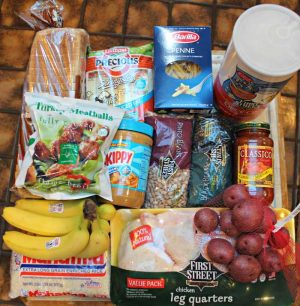his past month I participated in the
, a project focused on bringing greater awareness to the struggles of the nearly 47 million Americans who live on food stamps. This meant making numerous changes to my eating habits, since I only had around $4 a day to spend on food.
It took a little longer than 45 minutes for my nervousness to begin, when I had to explain to the friendly cashier at Safeway that I needed to return my apples because I was over budget. He gave me a funny look — probably because this isn’t normal behavior for most Cupertino kids — but after a few seconds he recovered, said he was sorry and printed out my receipt.
When I got home, I laid out my groceries, feeling rather optimistic. I had a few bananas, some potatoes and even managed to grab a whole chicken on sale for about $5.

Then the school week began and reality sunk in. It was difficult watching my friends chow down on Chipotle and Yogurtland while I munched away on a peanut butter sandwich. And even though my friends knew what I was doing, I couldn’t help but feel a bit isolated. I was living in a different world when it came to food, a world dominated by monochromatic, bland meals that I would eat for days at a time.
After the first week, my challenge became sour.
Before beginning, I had read blogs from numerous politicians, a few SNAP advocates and even the CEO of Panera, all of whom described their experiences as unequivocally eye opening, even if the simulation was only a taste of the real thing.
Once I changed my spending habits and bought in bulk, I was actually able to enjoy some fresh fruits and vegetables. Admittedly, it wasn’t as much as usual, but eating on a budget became manageable, definitely not painful. At lunch, eating my cruciferous vegetable mix with leftover chicken, things almost felt normal.
I certainly looked at my shopping cart differently, but I was also supposed to feel this radical empathy. I was supposed to find a new compassion for those living on food stamps because after all, I had just finished living for a month on food stamps.
Except I really wasn’t. The truth is that living on food stamps really is not just a numerical challenge. It’s not even the isolation or the occasionally embarrassing encounter with the cashier.
Indeed, this process was not really an exercise in radical empathy, but an exercise in radical self-indulgence. Here’s the thing: Living on $4 a day and living on food stamps are entirely different things.
When you live on food stamps, you are not doing it for a week or a month. It is a constant reality. You don’t get to go back to your Chipotle lunches and steak dinners, your Whole Foods salad mixes and farmers market fruit.
You eat the same sort of food every single day for years at a time. The same knock-off pasta brand. The same flavorless oatmeal. The same rice, beans, lentils and low-quality bread. And the occasional splash of color that you get from fruits or vegetables isn’t nearly enough.
Living on $4 a day and living on food stamps are entirely different things.
So I’m going to say it — the food stamp challenge is a hoax. Those politicians, CEOs and food advocates are full of crap.
The challenge exists to make participants feel good, like we’re making a difference and gaining some profound insight into a world that we had previously never experienced.
The reality is that food stamps are an embodiment of an overarching set of socioeconomic challenges.
Because if you’re on SNAP, you are probably feeding and caring for more than just yourself. You have to worry about medical bills, paying the rent and keeping your job. You don’t live knowing that your challenge has an end-date, an auspicious time when you can go back to eating the same food you’ve enjoyed for the rest of your life.
My aunt, who teaches in a low-income area of San Jose, explained that because parents are almost never home during the day, families regularly buy only what they can carry home in their arms. That is something impossible to factor into a budget challenge.
So as a participant, I was led to believe that I was going to have a profound experience, when in reality I was getting some sparkly version of what it’s like to be poor.
The bottom line here is not that we should stop participating in these sorts of advocacy challenges. Instead, we have to stop looking at them as an opportunity for some sort of self-awakening and see them as a narrow, impossibly simple version of the real thing. You cannot even call it an illusion. Because no matter how hard we try to be humble and keep our experience in context, it’s a replacement for actual empathy. Because someone will inevitably say that they’ve beaten the challenge and that being poor is actually easy.
If we really want to advocate for better SNAP benefits, or anything related to food in America we have do something other than play poor for a week.
We could start by addressing the fact that more than 26.5 million people in the United States live without access to a real grocery store. Or that obesity disproportionately affects those living in low-income neighborhoods because they have such limited access to healthy food. Or that millions of Americans trade-in their food stamp benefits to pay for necessities like shoes, school supplies and soap.
These challenges are not something that we can address in our suburban homes trying to simulate what it’s like to be hungry for a few weeks. These are challenges that require real advocacy and real change.
Why reduce ourselves to poverty when we can work to elevate people out of it?







